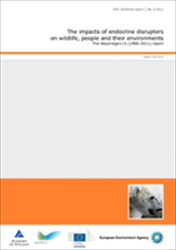Members Login

Channels
Special Offers & Promotions
Increase in cancers and fertility problems may be caused by household chemicals and pharmaceuticals
publication date: May 15, 2012
|
author/source: European Environment Agency
 Chemicals which disrupt the hormone system - also known
as ‘endocrine disrupting chemicals' (EDCs) - may be behind significant
increases in cancers, diabetes and obesity, falling fertility, and an increased
number of neurological development problems in both humans and animals,
according to a review of recent scientific literature commissioned by the
European Environment Agency (EEA).
Chemicals which disrupt the hormone system - also known
as ‘endocrine disrupting chemicals' (EDCs) - may be behind significant
increases in cancers, diabetes and obesity, falling fertility, and an increased
number of neurological development problems in both humans and animals,
according to a review of recent scientific literature commissioned by the
European Environment Agency (EEA). Chemicals which can potentially disrupt the endocrine system can be found in food, pharmaceuticals, pesticides, household products and cosmetics. In recent decades, there has been a significant growth in many human diseases and disorders including breast and prostate cancer, male infertility and diabetes. Many scientists think that this growth is connected to the rising levels of exposure to mixtures of some chemicals in widespread use.
"Scientific research gathered over the last few decades shows us that endocrine disruption is a real problem, with serious effects on wildlife, and possibly people", EEA Executive Director Jacqueline McGlade said. "It would be prudent to take a precautionary approach to many of these chemicals until their effects are more fully understood."
The Weybridge +15 (1996-2011) report on endocrine disruptors was launched at Brunel University outside London today. It is the result of an international workshop that evaluated the findings of the last 15 years of research. The report follows the 1996 Weybridge report and associated workshop, where the problem of EDCs was first comprehensively discussed by regulatory authorities and scientists together.
Reasons for scientific uncertainty
The report shows clearly that there is strong evidence of harm from EDCs in some wildlife species and in laboratory studies using rodent models for human health. However, the effects of EDCs on humans may be more difficult to demonstrate, due to the length, cost and methodological difficulties with these types of studies - so wildlife and animal studies may be seen in some cases as an early warning of the dangers.
In the last 10 years, risk assessment and regulatory frameworks for dealing with EDCs have been created and screening procedures have been developed to test chemicals for endocrine disrupting properties. There are still lots of factors that make the risk assessment process difficult. Chief amongst these is the fact that these chemicals can affect early development of, for example, the brain, reproductive, immune and metabolic systems in detrimental ways that are often invisible until several years or sometimes decades after exposure.
Scientific understanding is further complicated because mixtures of similarly acting EDCs in combination may contribute to an overall effect, whilst each of these chemicals alone may not cause harm. These factors make it hard for scientists to identify thresholds of exposure below which there are no effects.
However, there is a large body of evidence linking chemical exposure to thyroid, immune, reproductive and neurological problems in animals, and many of the same or similar diseases and disorders have been observed to be rising in human populations. Both animals and humans may be exposed to these chemicals in the environment, or via water or the food chain where the chemicals can build up.
Possible effects of endocrine disrupting chemicals
- The link between some diseases and EDCs is now accepted. For example, exposure to oestrogen or to oestrogenic EDCs is an accepted risk factor for breast cancer, endometriosis, fibroids and polycystic ovarian syndrome (PCOS) in women.
- Breast cancer rates are increasing in almost all industrialised countries. The majority of these cases are due to lifestyles and environmental exposures, rather than specific genetic factors.
- Some EDCs may also cause low quality semen - approximately 40% of European men suffer from reduced fertility. Detailed reviews of current knowledge show clearly that human male reproductive problems are increasing in many countries, and that environmental factors which disrupt the normal development of the foetal reproductive system are crucial in the development of these diseases and disorders.
- Laboratory studies show that the reproductive systems of a broad range of vertebrate species, for example polar bears and fish, and some invertebrate species such as some snails and oysters are susceptible to EDCs.
- Some studies have linked EDCs to thyroid disease. Thyroid cancer rates have increased by between 5 % (Switzerland) and 155 % (France), particularly in women, children and young adults.
- Several studies have also linked exposure to some EDCs with neurodevelopmental disorders such as autism, attention deficit disorder and diminished cognitive function in children. However, more work is needed in this area to confirm or refute theories involving the wider sphere of EDCs in modern commerce
- There is a trend towards the earlier onset of puberty in girls, which may be influenced by EDCs.
- Some persistent endocrine disrupting substances, such as DDT, TBT and PCBs - now banned or restricted in their use - have been shown to cause catastrophic declines in mollusc, seal and bird populations in some parts of the world as a result of their effects on reproduction. Scientists are concerned that many chemicals that are still in modern commerce also affect the human reproductive system.
To download a copy of the report click here
Media Partners


